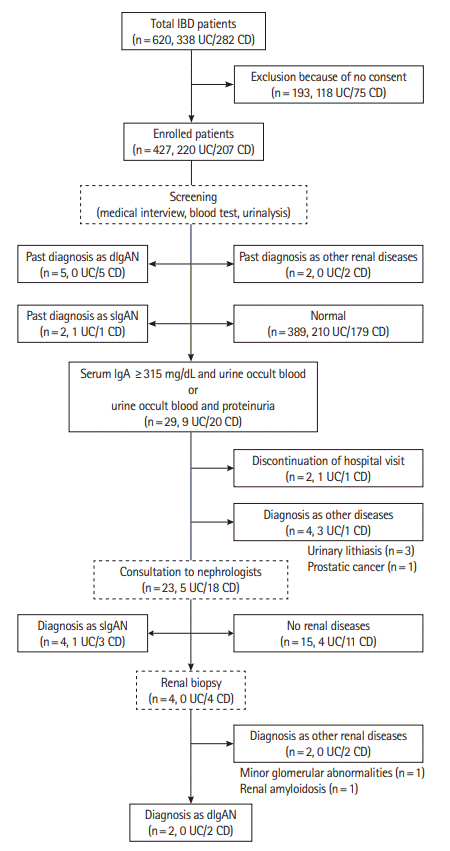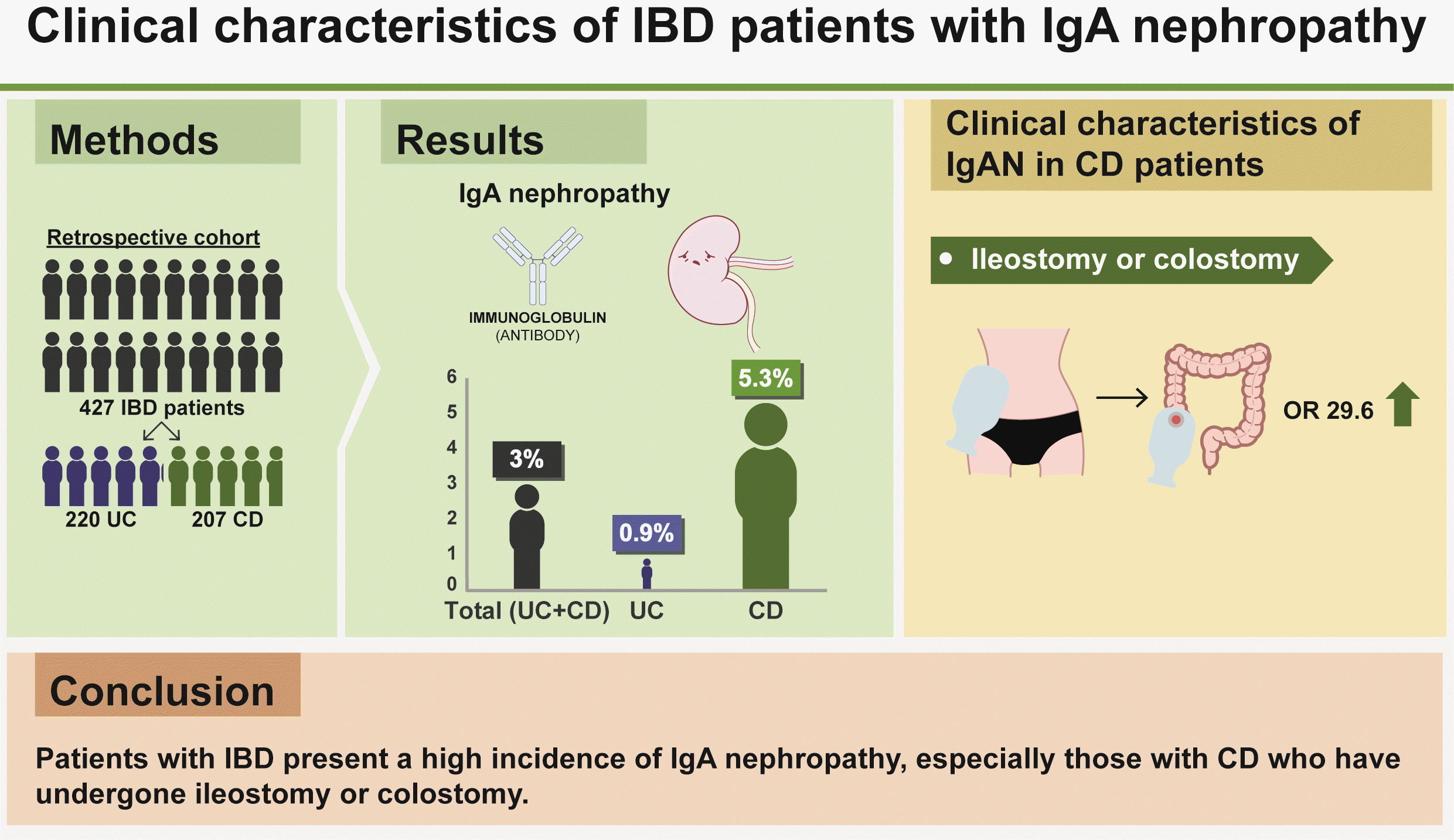1. Kaser A, Zeissig S, Blumberg RS. Inflammatory bowel disease. Annu Rev Immunol. 2010; 28:573–621.
2. Danese S, Fiocchi C. Ulcerative colitis. N Engl J Med. 2011; 365:1713–1725.

3. Maloy KJ, Powrie F. Intestinal homeostasis and its breakdown in inflammatory bowel disease. Nature. 2011; 474:298–306.
4. Gregory B, Ho VC. Cutaneous manifestations of gastrointestinal disorders. Part II. J Am Acad Dermatol. 1992; 26:371–383.
5. Gravallese EM, Kantrowitz FG. Arthritic manifestations of inflammatory bowel disease. Am J Gastroenterol. 1988; 83:703–709.
6. Orchard TR, Thiyagaraja S, Welsh KI, Wordsworth BP, Hill Gaston JS, Jewell DP. Clinical phenotype is related to HLA genotype in the peripheral arthropathies of inflammatory bowel disease. Gastroenterology. 2000; 118:274–278.

7. Ardizzone S, Puttini PS, Cassinotti A, Porro GB. Extraintestinal manifestations of inflammatory bowel disease. Dig Liver Dis. 2008; 40–Suppl 2:S253-S259.
8. Loftus EV Jr, Harewood GC, Loftus CG, et al. PSC-IBD: a unique form of inflammatory bowel disease associated with primary sclerosing cholangitis. Gut. 2005; 54:91–96.
9. Pardi DS, Tremaine WJ, Sandborn WJ, McCarthy JT. Renal and urologic complications of inflammatory bowel disease. Am J Gastroenterol. 1998; 93:504–514.

10. Donadio JV, Grande JP. IgA nephropathy. N Engl J Med. 2002; 347:738–748.

11. Takemura T, Okada M, Yagi K, Kuwajima H, Yanagida H. An adolescent with IgA nephropathy and Crohn disease: pathogenetic implications. Pediatr Nephrol. 2002; 17:863–866.

12. Ueno Y, Tanaka S, Onitake T, et al. Infliximab treatment for Crohn’s disease in a patient with IgA nephropathy. Clin J Gastroenterol. 2009; 2:380–383.
13. Forshaw MJ, Guirguis O, Hennigan TW. IgA nephropathy in association with Crohn’s disease. Int J Colorectal Dis. 2005; 20:463–465.

14. Marek-Bukowiec K, Konieczny A, Ratajczyk K, Witkiewicz W. Candidate urine peptide biomarkers for IgA nephropathy: where are we now? Dis Markers. 2018; 2018:5205831.

15. O’Shaughnessy MM, Hogan SL, Thompson BD, Coppo R, Fogo AB, Jennette JC. Glomerular disease frequencies by race, sex and region: results from the International Kidney Biopsy Survey. Nephrol Dial Transplant. 2018; 33:661–669.

16. Satsangi J, Silverberg MS, Vermeire S, Colombel JF. The Montreal classification of inflammatory bowel disease: controversies, consensus, and implications. Gut. 2006; 55:749–753.

17. Rachmilewitz D. Coated mesalazine (5-aminosalicylic acid) versus sulphasalazine in the treatment of active ulcerative colitis: a randomized trial. BMJ. 1989; 298:82–86.

18. Best WR, Becktel JM, Singleton JW, Kern F Jr. Development of a Crohn’s disease activity index. national cooperative Crohn’s disease study. Gastroenterology. 1976; 70:439–444.
19. Utsunomiya Y, Koda T, Kado T, et al. Incidence of pediatric IgA nephropathy. Pediatr Nephrol. 2003; 18:511–515.

20. McGrogan A, Franssen CF, de Vries CS. The incidence of primary glomerulonephritis worldwide: a systematic review of the literature. Nephrol Dial Transplant. 2011; 26:414–430.
21. Ambruzs JM, Walker PD, Larsen CP. The histopathologic spectrum of kidney biopsies in patients with inflammatory bowel disease. Clin J Am Soc Nephrol. 2014; 9:265–270.
22. Wyatt RJ, Julian BA. IgA nephropathy. N Engl J Med. 2013; 368:2402–2414.

23. Coppo R. The intestine-renal connection in IgA nephropathy. Nephrol Dial Transplant. 2015; 30:360–366.

24. Cesta MF. Normal structure, function, and histology of mucosa-associated lymphoid tissue. Toxicol Pathol. 2006; 34:599–608.

25. Kiryluk K, Novak J. The genetics and immunobiology of IgA nephropathy. J Clin Invest. 2014; 124:2325–2332.

26. Nagy J, Scott H, Brandtzaeg P. Antibodies to dietary antigens in IgA nephropathy. Clin Nephrol. 1988; 29:275–279.
27. Kamata T, Nogaki F, Fagarasan S, et al. Increased frequency of surface IgA-positive plasma cells in the intestinal lamina propria and decreased IgA excretion in hyper IgA (HIGA) mice, a murine model of IgA nephropathy with hyperserum IgA. J Immunol. 2000; 165:1387–1394.

28. Kiryluk K, Novak J, Gharavi AG. Pathogenesis of immunoglobulin A nephropathy: recent insight from genetic studies. Annu Rev Med. 2013; 64:339–356.

29. Wehkamp J, Salzman NH, Porter E, et al. Reduced Paneth cell alpha-defensins in ileal Crohn’s disease. Version 2. Proc Natl Acad Sci U S A. 2005; 102:18129–18134.
30. Hayashi R, Tsuchiya K, Fukushima K, et al. Reduced human α-defensin 6 in noninflamed jejunal tissue of patients with Crohn’s disease. Inflamm Bowel Dis. 2016; 22:1119–1128.






 PDF
PDF Citation
Citation Print
Print




 XML Download
XML Download